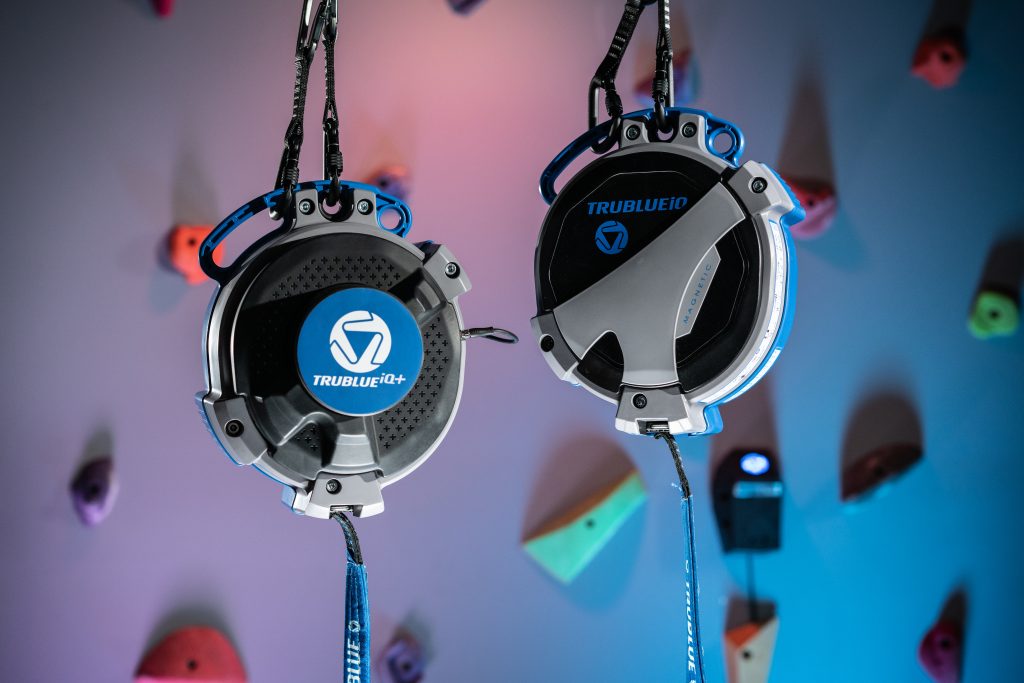Key Takeaways:
- Belay Devices in Climbing Gyms: The choice of belay devices in your gym significantly impacts the safety and experience of climbers.
- Variety of Belay Devices: Different Belay devices, including manual and automatic systems, cater to various climbing scenarios and skill levels.
- Innovative Climbing Technology: Head Rush Technologies offers innovative belayer devices designed to elevate the climbing experience, focusing on quality, safety, and user engagement.
In the climbing world, the belay device acts as a linchpin for safety, enabling climbers to scale heights with confidence and security. With an array of belay devices available, each tailored to specific climbing environments and objectives, choosing the right one for your gym can be a pivotal decision. This choice impacts climbers' safety and enhances their climbing experience, making it seamless and enjoyable.
As leaders in the adventure industry, we at Head Rush Technologies understand the gravity of selecting the right belay devices for climbing gyms — a decision that influences the caliber of climbing adventures your facility can offer. Our mission has always been to empower epic adventures, ensuring every climb is memorable, safe, and exhilarating.
In this article, we'll explore the different types of belay devices, emphasizing the innovation and adventure inherent to our designs. We'll also guide you in selecting the best fit for your gym's unique needs and aspirations. Join us on this adventurous journey to elevate the climbing experience at your gym with the optimal blend of safety, quality, and exhilaration.
What Are Belay Devices?
Belay devices have evolved significantly, transitioning from simple, manual devices to sophisticated, automated systems with enhanced safety features and user-friendly functionalities. A belay device acts as a brake on the climbing rope, which allows the belayer to easily catch a fall, control the descent, and provide a smooth experience for the climber. Several types of belay devices are available in the market, each with its unique advantages and suited to different climbing environments.
The traditional tubular devices, for example, are cherished for their simplicity and versatility, making them a staple in the toolkits of many climbers. Assisted braking devices provide an additional layer of safety, making them particularly appealing for beginner climbers and climbing gyms looking to enhance the safety of their clientele. However, the most innovative leap in belaying technology has been the introduction of auto-belay devices.
For climbing gym owners, choosing the right type of belay device is a big decision—not only to ensure the safety of their guests but also to enhance the overall climbing experience. As leaders and innovators in the adventure industry, our goal at Head Rush Technologies is to help you make informed decisions that align with your mission to provide epic adventures for all.

Different Belay Devices Explained
When outfitting your climbing gym, selecting the appropriate belay device is crucial. It not only impacts the safety of climbers but also influences their climbing experience. Understanding the different types of belay devices will help you make an informed decision that aligns with your gym's needs. Here, we explain the main categories of belay devices and how they cater to various climbing scenarios.
Manual Belay Devices
- Tubular Devices: Tubular devices are perhaps the most common type of belay device, known for their versatility and ease of use. Tubular devices, such as the ATC (Air Traffic Controller), allow for smooth rope feeding and effective braking by creating friction. They are suitable for lead climbing and top roping, making them a great all-rounder for gyms.
- Figure 8 Devices: Named after their shape, Figure 8 devices provide a smooth rappelling experience but are less common for belaying in gyms. They facilitate quick rope release and are primarily used in rescue operations or rappelling.
- Assisted Braking Devices: These devices include a mechanism that assists in braking when a climber falls. Devices like the GriGri offer an added layer of safety, making them popular in lead climbing and top roping. They're especially favored by gyms for beginners, providing peace of mind to both climbers and facility operators.
Automatic Belay Devices
- Auto Belay Devices: Revolutionizing the climbing gym experience, auto belay devices remove the need for a human belayer. Our TRUBLUE Auto Belay devices allow climbers of all skill levels to focus solely on their climb without worrying about the belay process. They are an ideal solution for gyms looking to provide a hassle-free climbing experience for solo climbers or those without a climbing partner.
Selecting the right belay device for your gym involves considering your clientele's skill levels, the types of climbing you wish to offer, and the overall atmosphere you aim to create. Whether manual or automatic, each device serves a unique purpose and contributes to the safety and enjoyment of climbing.
Head Rush Tech Belay Devices
At Head Rush Technologies, we stand at the forefront of innovation with our belay devices designed to meet the unique needs of climbing gym owners and their patrons. We've engineered a range of belay devices that seamlessly integrate safety, efficiency, and the ultimate climbing experience. Explore our products at Head Rush Tech Belay Devices and discover how we're transforming climbing one belay at a time.
TRUBLUE iQ
Introducing the next-generation TRUBLUE iQ: lighter, more compact, and tougher than ever. Ideal for indoor and outdoor climbing walls, this cutting-edge auto belay device features a magnetic braking system for a soft, smooth descent and is suitable for climbers of all ages. TRUBLUE iQ meets stringent safety standards, ensuring protection against dynamic falls and offering an authentic climbing experience with an unassisted ascent.
TRUBLUE iQ+
Discover the TRUBLUE iQ+, the world's first and only auto belay featuring premium catch-and-hold technology. Built on the robust iQ platform, the iQ+ offers the same high durability, magnetic braking, and authentic unassisted ascent experience as the TRUBLUE iQ. Certified to meet the highest safety standards, including comprehensive protection against dynamic falls, the iQ+ enhances climbing training and performance by allowing climbers to pause and strategize mid-climb.
TRUBLUE Speed
Experience the pinnacle of speed climbing with TRUBLUE Speed, an auto belay designed for high-intensity and competitive climbing environments. This advanced system is engineered for rapid retraction and minimal resistance, enabling faster ascents without impacting performance. TRUBLUE Speed maintainsthe same high durability, magnetic braking, and safety standards as the TRUBLUE iQ, including protection against dynamic falls. It's optimal for facilities hosting speed climbing competitions or training sessions, helping climbers push their limits safely and effectively.
The Versatile Range
Beyond the TRUBLUE Auto Belay, our product portfolio includes a variety of devices to cater to every aspect of the adventure experience. Head Rush Technologies leaves no stone unturned, from zip line brakes that promise an exhilarating yet secure adventure to advanced free-fall devices that mimic the rush of skydiving. We prioritize the adrenaline and the peace of mind that comes with top-tier safety standards.
As leaders in the adventure industry, we're committed to pushing the boundaries of what's possible. Our devices are manufactured in the USA, ensuring every product meets the stringent quality and safety standards that climbing gym owners and their clients deserve. By choosing Head Rush Technologies, you're not just equipping your gym with state-of-the-art belay devices; you're also investing in a partnership dedicated to the success of your climbing community.
How To Choose The Right Belay Device For Your Gym
Selecting the right belay device is crucial for enhancing the climbing experience, ensuring safety, and facilitating seamless operations. Here’s how to find the perfect fit for your facility:
Assess Your Gym's Specific Needs
Evaluate your gym’s unique character, clientele, and requirements. Consider the skill levels of your climbers, the type of climbing you offer (lead climbing, top roping, bouldering), and specific goals such as increasing throughput or enhancing safety. For gyms focusing on beginners or offering a range of classes, prioritize easy-to-use, reliable devices.
Consider Safety And Reliability
Choose Belay devices known for their safety features, reliability, and strong reputation in the climbing community. Devices should be intuitive for climbers of all levels to minimize misuse and accidents.
Look For Versatility And Ease Of Use
Opt for devices that accommodate various climber weights and integrate easily into different climbing routes. Versatile, easy-to-manage belay devices enhance climbers' experiences and simplify operations for your staff.
Evaluate Maintenance And Support
Choose devices with robust support networks and straightforward maintenance requirements. Reliable customer support and easy maintenance ensure long-term durability and operational efficiency.
Safety Features To Look For
When selecting a belay device for your climbing gym, safety is paramount. Here are essential safety features to consider:
- Auto-Locking Function: This function ensures the device can automatically arrest a fall without manual intervention, providing an added layer of safety.
- Controlled Descent: Allows climbers to descend safely, which is especially important in auto belay devices like the TRUBLUE Auto Belays with magnetic braking technology.
- Durability and Reliability: Opt for devices made with robust materials that withstand daily use, reducing the need for frequent replacements.
- Redundant Systems: Additional safety mechanisms that act as a backup in case the primary system fails, enhancing overall security.
- Ease of Use: Devices should be user-friendly to minimize operator error, a leading cause of climbing accidents.
- Certification and Compliance: Ensure devices are certified and comply with industry standards (ANSI, EN) to guarantee safety and effectiveness.

Final Thoughts
Choosing the right belay device for your climbing gym is more than just selecting a piece of equipment. It's about partnering with a team that understands the heart of climbing and the drive behind every adventure. At Head Rush Technologies, we embody the spirit of innovation, trust, and leadership in everything we do. Our commitment to quality, customer-centric solutions, and the relentless pursuit of connecting passion with purpose sets us apart.
When you select from our range of belay devices, you're not just picking a product. You're choosing a partner dedicated to empowering epic adventures and ensuring safety and satisfaction for all your guests. Our TRUBLUE Climbing Auto Belays, designed by climbers for climbers, are a testament to our innovative approach and adventurous spirit. Every detail, from the drawing board to the final product, is engineered with the user's experience in mind.
Read also:
- Climbing On Auto Belay: What You Need To Know
- How to Choose Your TRUBLUE Auto Belay
- How to Replace the Webbing in a TRUBLUE iQ or iQ+ Auto Belay
Frequently Asked Questions About Belay Devices
Equipping yourself with the right knowledge and gear can make all the difference in the climbing world. Here's a quick guide to frequently asked questions about belay devices to ensure you're well informed and ready to make the best choice for your climbing needs.
What is a belay device?
A belay device is a mechanical piece of climbing equipment used to control a rope during belaying. It provides friction that helps slow down or stop the rope with minimal effort from the belayer, which is crucial for the climber's safety.
How many types of belay devices are there?
Climbers can choose from several types of belay devices, such as tubular, assisted-braking, figure 8, and passive devices. Each serves different needs and offers varying levels of friction and control.
What are tubular belay devices?
Tubular belay devices, often referred to as ATC (Air Traffic Controller) devices, have two slots through which the rope is threaded. They depend on the belayer's brake hand and body movements to manage the rope's friction and speed. Lightweight and versatile, they are suited for lead climbing and top-roping scenarios.
How does an assisted-braking belay device work?
Assisted braking devices are designed with a feature that automatically applies friction to the rope when a sharp force is sensed, such as in a fall. This assistance provides the belayer with additional support in arresting a climber's fall. Some models suit various climbing styles, including lead climbing and top-roping.
What is a figure 8 belay device?
Named for its shape, the figure 8 belay device has a large end that facilitates heat dissipation over a broad surface area. It is primarily used for rappelling and offers less control during belaying, making it a less popular choice in gym settings.
What are passive belay devices?
Passive belay devices do not have moving parts or assisted braking mechanisms. The belayer's technique and body strength are solely responsible for stopping the rope and arresting falls. Tubular and Figure 8 devices are examples of passive devices.
Are there belay devices specific to gym climbing?
Certain belay devices are tailor-made for the unique demands of gym climbing. The TRUBLUE Auto Belay, for example, is engineered to enhance the indoor climbing experience with features like an automatic retracting system and a smooth descent for climbers.
How do I choose the right belay device for my gym?
To select the ideal belay device for your gym, consider the skill levels of the climbers that frequent your facility, the type of climbing offered (lead climbing, top-roping, or both), and the preferred user experience. Auto belays like TRUBLUE are designed to meet the needs of climbers across a broad spectrum of abilities and provide an efficient experience for gym operators.
What is the difference between a single and dual-rope belay device?
Single-rope devices cater to climbing with one rope and are commonly found in sports climbing and indoor gyms. Conversely, dual-rope devices can handle two ropes concurrently, offering advantages in traditional or multi-pitch climbs where managing rope drag is challenging.
Can I use a lead climbing belay device for top-roping?
Most devices made for lead climbing can also serve as top-roping devices. That said, certain belay devices are optimized explicitly for one style over the other, so users must understand the device's design intentions and constraints before using it in a different context.



